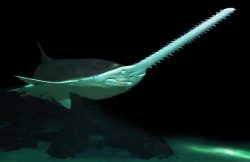select your film:


Smalltooth Sawfish, also called wide sawfish, are found in shallow tropical waters in coastal and estuarine parts of the Atlantic in depths of eight to 122 m. They are critically endangered, and are now non-existent in their previous habitat range off the coasts of: Honduras, Belize, Cuba, Sierra Leone and possibly Guinea-Bissau and Mauritania.
Biology and Behaviour
Smalltooth sawfish frequent soft bottoms over mud or sand, but they can also be found over hard rocky bottoms or coral reefs in areas with mangroves or seagrass.
They can vary in colour from brownish-grey, grey, bluish-grey to blackish with an off-white underside. They have a relatively narrow rostrum with 20 to 32 teeth on each side.
Their rostrum is made up of thousands of sensory organs that allow them to detect and monitor the movements of other organisms by measuring the electric fields other creatures emit. The sensory organs, also known as ampullary pores, are packed most densely on the dorsal side of its beak. This allows the sawfish to create an image of the three-dimensional area above it, even in waters of low-visibility. They use their snout to “view” their surroundings by resting low on the sea floor.
Similar to other sawfish, smalltooth sawfish feed on bottom-dwelling crustaceans and mollusks. They use their saw to dig and uncover hidden food in mud or sand.
Although sawfish use their saw to mainly hunt for food, they also use their it as self-defence mechanism against predators by moving it from side-to-side powerfully.
Reproduction and Lifespan
Smalltooth sawfish are ovoviviparous with a litter size between 15 to 20 pups born every other year. The pups are 61 cm long at birth and can grow up to 5.54 m long weighing up to 350 kg.
Conservation and Tourism
Smalltooth sawfish are listed as critically endangered by the IUCN.
All sawfish are listed on the Appendix I of the Convention of International Trade of Endangered Species (CITES) which bans commercial international trade of sawfish and only of their parts.
The United States implemented protections for smalltooth sawfish. It’s illegal to engage with smalltooth sawfish in anyway that’ll harm or capture them. Critical Habitat, a conservation organization, helps to protect juvenile nursery areas in order for the sawfish to reach adulthood.
Nicaragua also imposed a permanent ban on sawfish fishing in Lake Nicaragua. In Brazil, smalltooth sawfishes are protected by the Ministry of Environment and in Mexico the take of all sawfish is banned. Sawfishes are protected in the Exclusive Economic Zone, an area where a country claims exclusive rights for fishing, drilling etc., in Guinea and Senegal and in Marine Protected Areas in Mauritania and Guinea-Bissau.
Smalltooth sawfish were once spotted off the coasts of 47 countries, but that number has been reduced to six.
There are a handful of public aquariums that keep smalltooth sawfishes in North America and one in Columbia.
Do you have images or videos of Smalltooth Sawfishs?
Submit them to [email protected].
